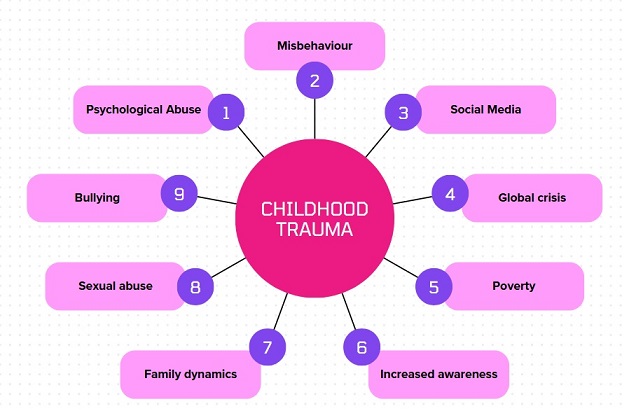
In today’s rapidly changing world, the need for childhood trauma therapists is more pressing than ever. With shifting social norms, economic uncertainties, technological advancements, and global crises, children are increasingly exposed to a range of stressors that can lead to trauma. Childhood trauma, whether resulting from abuse, neglect, loss, or environmental factors, has long-lasting effects on mental and physical health. Addressing this growing concern requires a multifaceted approach and a deeper understanding of why specialized therapists are crucial.
Understanding Childhood Trauma
Childhood trauma encompasses any adverse experience that overwhelms a child’s ability to cope. This can include physical, emotional, or sexual abuse; witnessing domestic violence; bullying; or living through natural disasters. More subtle forms of trauma, such as neglect, emotional unavailability from caregivers, or chronic stress due to poverty, can also leave indelible marks.
The brain of a child is incredibly plastic, meaning it is highly responsive to experiences, both positive and negative. Traumatic events during formative years can alter brain development, impacting areas responsible for emotional regulation, memory, and stress response. Without intervention, these changes may lead to mental health challenges such as anxiety, depression, post-traumatic stress disorder (PTSD), and difficulty forming healthy relationships later in life.
Factors Driving the Increased Need for Childhood Trauma Therapists
Several contemporary factors contribute to the rising demand for therapists specializing in childhood trauma. Let’s explore these drivers in detail:
- Global Crises and Disasters
- Natural disasters, pandemics, and political conflicts have become more frequent and severe. Events like the COVID-19 pandemic have upended the lives of millions of children, leading to isolation, disrupted education, and increased exposure to domestic violence.
- Climate change-related disasters such as hurricanes, wildfires, and floods force families to relocate and live in precarious conditions, causing immense stress for children. These crises also expose children to sudden and traumatic losses, amplifying their need for therapeutic support.
- Technological Advancements and Social Media
- While technology has connected the world, it has also exposed children to cyberbullying, online predators, and harmful content. Social media’s impact on self-esteem and mental health is profound, with many children developing anxiety and depression from unrealistic comparisons and digital harassment.
- Excessive screen time and online interactions can hinder the development of crucial social skills and emotional intelligence. For many children, the digital world becomes a source of trauma when they face exclusion, body shaming, or exploitation online.
- Increasing Awareness of Mental Health
- In previous generations, mental health issues were often stigmatized or ignored. Today, there is a growing recognition of the importance of mental well-being, leading to more parents and educators seeking help for children who show signs of trauma.
- This increased awareness, while positive, has also highlighted the gap between demand and the availability of trained childhood trauma therapists. More parents are now seeking preventive interventions, adding to the strain on the mental health system.
- Economic Inequality and Poverty
- Economic disparities continue to widen, exposing children in low-income families to chronic stress, food insecurity, and unstable living conditions. Such environments are breeding grounds for trauma.
- Children in marginalized communities are disproportionately affected, often facing systemic barriers to accessing mental health care. The stress of growing up in poverty is compounded by social stigma, making it harder for families to seek therapy.
- Shifts in Family Dynamics
- Divorce rates, single-parent households, and blended families have become more common. While these family structures can be healthy and nurturing, they can also create environments where children may feel instability or loss.
- Parental mental health issues, substance abuse, and intergenerational trauma also contribute to adverse childhood experiences (ACEs). The absence of consistent and nurturing caregiving exacerbates the psychological toll on children.
The Role of Childhood Trauma Therapists
Childhood trauma therapists play a pivotal role in helping young individuals process and recover from traumatic experiences. Their work involves:
- Assessment and Diagnosis: Therapists use various tools and techniques to understand the nature and extent of a child’s trauma. Standardized assessments like the ACE questionnaire provide a framework for identifying risk factors.
- Creating Safe Spaces: Building trust and safety is paramount for effective therapy, allowing children to express themselves without fear of judgment. Therapists often use creative methods like art and storytelling to help children communicate.
- Evidence-Based Interventions: Approaches like Cognitive Behavioral Therapy (CBT), Eye Movement Desensitization and Reprocessing (EMDR), and play therapy are tailored to the developmental stage and unique needs of each child. These methods are continually refined to address complex trauma more effectively.
- Family Involvement: Therapists often work with families to improve communication, address systemic issues, and create supportive environments. Parents are guided to adopt trauma-informed caregiving practices to aid recovery.
- Advocacy and Collaboration: Childhood trauma therapists collaborate with schools, social workers, and other professionals to ensure comprehensive care. This multidisciplinary approach addresses the child’s needs holistically.
Challenges Faced by Childhood Trauma Therapists
Despite their critical role, childhood trauma therapists face numerous challenges:
- High Demand, Limited Supply: The rising need for specialized therapists often outpaces the availability of trained professionals. This shortage delays intervention, potentially worsening outcomes for children.
- Burnout: Dealing with traumatic stories daily can lead to emotional exhaustion and burnout among therapists. Organizations need to prioritize the mental health of these caregivers.
- Stigma: While awareness has improved, stigma around mental health persists in many communities, preventing children from receiving timely help. Therapists often have to navigate cultural and societal barriers to provide care.
- Resource Constraints: Schools and community centers often lack the funding and resources to provide adequate mental health support. Underfunded systems leave therapists overwhelmed and under-supported.
Addressing the Growing Need
To meet the increasing demand for childhood trauma therapists, systemic changes are necessary:
- Enhanced Training and Education
- Universities and professional programs should expand their offerings to include specialized courses in childhood trauma therapy. Advanced certifications in trauma-focused techniques should be made more accessible to therapists.
- Continuing education opportunities for practicing therapists can help them stay updated on the latest research and techniques. Incorporating cultural competence into training ensures therapists can address diverse client needs.
- Increased Funding and Accessibility
- Governments and organizations need to invest in mental health infrastructure, ensuring affordable and accessible care for all children. Expanding Medicaid coverage for therapy services can bridge the gap for low-income families.
- Teletherapy can bridge the gap for children in remote or underserved areas. Digital platforms designed for children’s therapy can make sessions engaging and effective.
- Public Awareness Campaigns
- Educating parents, teachers, and communities about the signs of childhood trauma and the benefits of therapy can reduce stigma and encourage early intervention. Community workshops and school programs can play a vital role.
- Support for Therapists
- Providing mental health support and supervision for therapists can help mitigate burnout and improve the quality of care. Peer support groups and regular debriefing sessions are essential.
- Policy Changes
- Policymakers should prioritize mental health in education and healthcare systems, mandating the inclusion of trauma-informed practices in schools and other child-focused settings. Funding research into childhood trauma and intervention outcomes is equally important.
Case Studies: Real-Life Impacts of Therapy
- Healing Through Play Therapy:
- A six-year-old girl who witnessed domestic violence began showing signs of withdrawal and aggressive behavior. Through structured play therapy, she learned to express her emotions and developed coping mechanisms to handle her anxiety. Her therapist also worked with her mother to create a safer home environment.
- Overcoming Bullying with CBT:
- An eleven-year-old boy who experienced severe bullying at school developed symptoms of PTSD, including nightmares and fear of attending classes. Cognitive Behavioral Therapy helped him reframe his thoughts, rebuild his self-esteem, and confront his fears. Collaboration between his therapist and school staff ensured a safer and more inclusive environment.
- EMDR for Traumatic Loss:
- A teenager who lost both parents in a car accident struggled with grief and flashbacks. Eye Movement Desensitization and Reprocessing (EMDR) therapy helped her process the traumatic memories and reduce their emotional intensity. Over time, she regained a sense of normalcy and hope for the future.
- Group Therapy in Schools:
- In an urban school district, group therapy sessions were introduced to support children who had experienced community violence. These sessions provided a safe space for children to share their experiences and learn coping strategies collectively. The initiative resulted in improved academic performance and reduced behavioral issues among participants.
The Future of Childhood Trauma Therapy
As society becomes more attuned to the impact of early trauma, the role of childhood trauma therapists will continue to evolve. Innovations in neuroscience, technology, and therapeutic approaches offer promising avenues for more effective interventions.
For example:
- Virtual Reality Therapy: Immersive experiences can help children process trauma in a controlled and safe environment. For instance, recreating a safe version of a triggering environment can help desensitize children to distressing memories.
- Artificial Intelligence (AI): AI-driven tools can assist therapists in diagnosing and monitoring progress. Chatbots equipped with trauma-informed responses can provide supplementary support between sessions.
- Trauma-Informed Schools: Integrating mental health support within educational systems ensures early detection and intervention. Teachers trained in trauma awareness can create safer and more understanding classrooms.
- Community-Based Programs: Local initiatives that provide free or low-cost therapy sessions in underserved areas can expand access to care. These programs often rely on partnerships between governments, NGOs, and private sectors.
Long-Term Benefits of Addressing Childhood Trauma
Addressing childhood trauma yields a wide range of long-term benefits, both at the individual and societal levels. Below are the subheadings that delve deeper into these impacts:
1. Improved Mental and Emotional Health
Early intervention helps mitigate the lasting effects of childhood trauma on mental health. Therapy equips children with coping mechanisms and tools to navigate challenging emotions. As they grow, individuals are less likely to develop chronic mental health conditions like depression, anxiety, and PTSD. This leads to greater emotional resilience and the ability to handle future stressors constructively.
2. Enhanced Physical Health
The mind-body connection is well-documented, and untreated trauma can manifest in physical health problems such as heart disease, obesity, and autoimmune disorders. By addressing trauma early, individuals are less likely to adopt unhealthy coping mechanisms like substance abuse or overeating. The result is a reduction in healthcare costs and an overall improvement in quality of life.
3. Stronger Relationships and Social Skills
Children who receive therapy are better equipped to form healthy relationships and build trust with others. They learn to communicate effectively, resolve conflicts, and maintain emotional boundaries. These skills are crucial for personal and professional relationships, contributing to overall life satisfaction and stability.
4. Breaking Cycles of Trauma
Therapy interrupts the intergenerational transmission of trauma. By healing their wounds, individuals are less likely to perpetuate harmful behaviors or patterns in their families. This has a ripple effect, fostering healthier communities and reducing the prevalence of adverse childhood experiences in future generations.
5. Economic and Educational Benefits
Children who recover from trauma are more likely to succeed academically and pursue higher education or vocational training. This opens doors to better career opportunities and financial stability. On a societal level, reducing the burden of untreated trauma contributes to a more productive workforce and economic growth.
6. Reduced Societal Costs
Addressing childhood trauma reduces the societal costs associated with untreated mental health issues, criminal behavior, and chronic health conditions. Investment in therapy and mental health services results in long-term savings for healthcare, education, and criminal justice systems.
7. Fostering a Healthier Society
A society that prioritizes the mental health of its youngest members creates an environment where empathy, understanding, and resilience thrive. By supporting children through their trauma, communities can nurture future leaders and contributors who are emotionally balanced and driven to create positive change.
Conclusion
The increasing need for childhood trauma therapists is a reflection of the complex challenges facing today’s children. By investing in specialized care and fostering a supportive environment, society can help young individuals heal and thrive. Addressing childhood trauma is not just a matter of individual well-being; it’s an investment in the collective future. Every child deserves the chance to grow into a healthy, resilient adult, free from the shadows of past trauma. By prioritizing early intervention, equipping therapists with resources, and destigmatizing mental health care, we can create a brighter future for generations to come.

